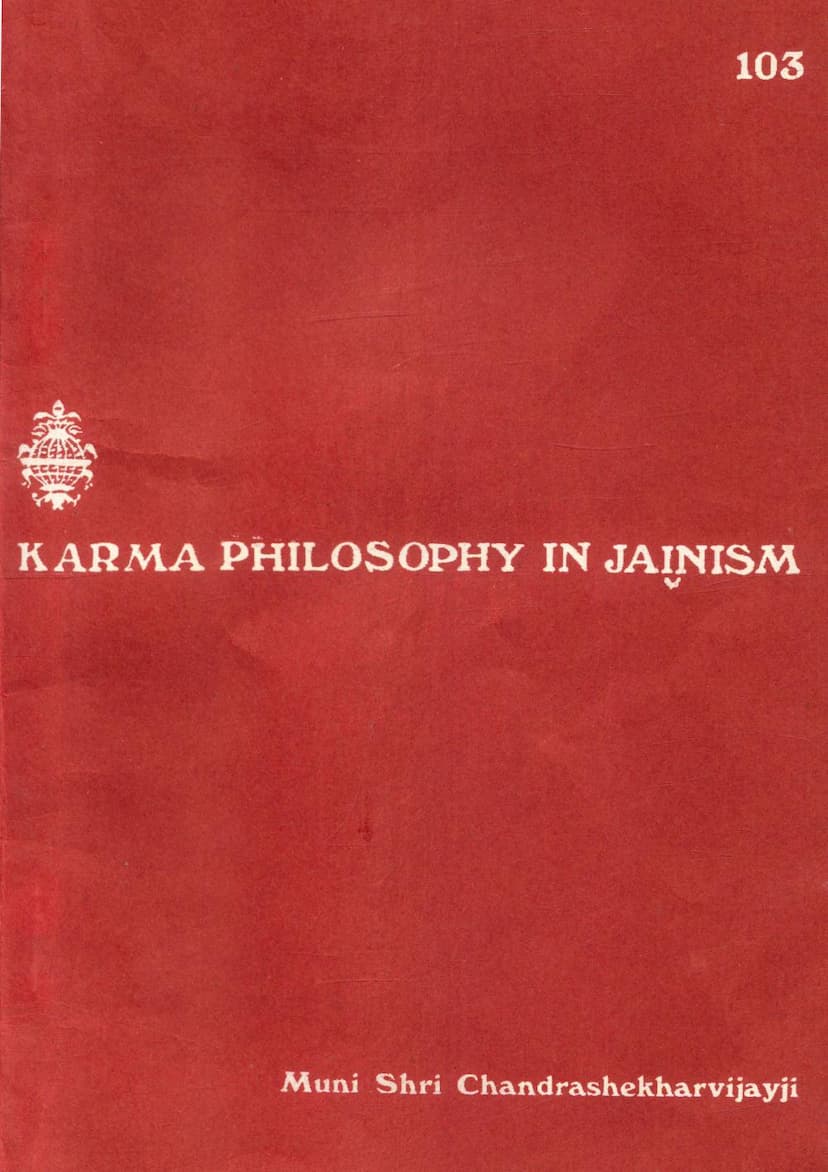Karma Philosophy In Jainism
Added to library: September 2, 2025

Summary
This document is the English translation of Muni Shri Chandrashekharvijayji's book on "Karma Philosophy in Jainism," translated by Chunilal Vrajlal Modi and published by Kamal Prakashan in 1978.
The book is presented as a comprehensive explanation of the Jain doctrine of Karma, emphasizing its central role in understanding the human condition and the path to liberation.
Here's a summary of the key themes and concepts covered in the provided text:
Author and Translator:
- Author: Muni Shri Chandrashekhar Vijayji, a respected Jain monk known for his prolific writing, oratory, and dedication to Jain principles. The text highlights his spiritual journey and commitment to societal upliftment.
- Translator: Chunilal Vrajlal Modi, who undertook the task of translating the Gujarati work into English, aiming to faithfully convey the original meaning.
Core Tenets of Jain Karma Philosophy:
- Man is the Architect of His Own Destiny: Jainism is presented not as a religion of fatalism but as one of activism, where individuals are responsible for their actions and the consequences they entail. "As you sow, so shall you reap" is a central principle.
- Soul and Karma: The soul (Jiva) and Karma are the two fundamental pillars of Jainism. The soul is eternal, conscious, and inherently pure, but its true nature is obscured by the influx of Karma.
- The Nature of Karma: Karma is described as a subtle form of matter that adheres to the soul, influencing its experiences, circumstances, and future births. It is not an external force or divine judgment but a consequence of one's own actions.
- Causes of Karma Bondage: The book details the four primary causes for the soul's bondage to Karma:
- False Belief (Mithyatva): Lack of unwavering fidelity to truth.
- Absence of Right Conduct (Avirti): Not adhering to virtuous practices.
- Passions (Kashaya): Unhealthy vibrations of anger, conceit, deceit, and greed.
- Activity (Yoga): Actions of mind, speech, and body.
- The Four States of Karma: When Karma attaches to the soul, its nature, duration, strength, and quantity are determined.
- Nature: This refers to the type of experience the Karma will produce (e.g., knowledge-obscuring, perception-obscuring, deluding, or energy-obscuring).
- Duration: The period for which the Karma will remain attached to the soul, ranging from a moment to innumerable years.
- Strength: The intensity with which the Karma will manifest its effects, categorized into four classes (weak to highly powerful).
- Quantity: The sheer amount of Karmic particles that adhere to the soul, often described as infinite.
- Transformation of Karma: A crucial aspect is the possibility of transforming the nature, duration, and strength of Karmas, especially during their dormant state. Righteous thoughts, penance, austerities, and virtuous conduct can modify the effects of past Karma and prevent the influx of new Karma.
- Annihilation of Karma for Liberation: The ultimate goal is to annihilate all Karmic coverings, thereby freeing the soul from the cycle of birth and death and realizing its inherent pure and blissful state (Godhood or liberation).
- The Role of Austerities and Right Conduct: The book emphasizes practices like fasting, penance, renunciation, virtuous thoughts, speech, and actions as means to shed Karma and achieve liberation. Devotion to virtuous souls (saints) is also highlighted as a catalyst for spiritual progress.
Illustrative Examples and Analogies: The book uses numerous real-life scenarios and analogies to illustrate complex concepts:
- Episodes of Suffering: The initial chapters present episodes of extreme poverty, disease, parental suffering, childlessness, and financial ruin to demonstrate how life's events are often inexplicable by ordinary means and point towards the operation of Karma.
- Historical Figures: Examples like Hitler, Napoleon, Omkarnath Thakur, wrestler Gama, Lal Bahadur Shastri, J.F. Kennedy, and Mahatma Gandhi are used to highlight the unpredictable turns of fortune and the profound influence of Karma.
- Time-Bombs: Karmas are likened to time-bombs that explode after a certain dormant period, bringing forth their effects.
- Reservoir Analogy: The soul is compared to a reservoir, with pipelines representing the causes of Karma influx. Blocking these pipes (through spiritual practices) prevents new Karma from entering, while drying up the existing reservoir (through austerities) leads to liberation.
- Computer and Science: The text draws parallels between the energy of matter described in modern science (computers, rockets) and the immense power of Karma, arguing that matter itself possesses immense energy, and Karma, being a subtle form of matter, wields significant influence. The book also cites Alexander Cannon's experiments on hypnotism to support the concepts of reincarnation and the law of Karma.
Key Takeaways:
- Personal Responsibility: Individuals are solely responsible for their present and future circumstances.
- Active Role in Spiritual Growth: Liberation is not passively received but actively achieved through diligent practice of Jain principles.
- The Power of Transformation: Past negative Karmas can be modified, and future positive outcomes can be cultivated through conscious effort and virtuous living.
- The True Nature of Happiness: Lasting happiness is not found in external material possessions or sensual pleasures but in the soul's inherent purity and freedom from Karmic bondage.
- The Value of Human Life: Human birth is considered rare and precious, offering the unique opportunity to break free from the cycle of Karma.
In essence, "Karma Philosophy in Jainism" aims to provide a clear, logical, and insightful explanation of a fundamental Jain doctrine, empowering readers with the understanding that their lives are shaped by their actions and offering a roadmap towards spiritual emancipation through diligent adherence to religious principles.